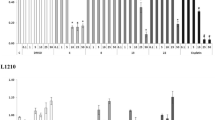Abstract
The epoxide-bearing valepotriates valtrate/isovaltrate and dihydrovaltrate, isolated from Valerianaceae roots and used as common sedative drugs, were investigated for their effects on untransformed hematopoietic cells after an alkylating potential and cytotoxicity to tumor cells had been found. The compounds were added to sensitive in vitro assays using granulocyte/macrophage (GM-CFC) and erythrocyte (E-CFC) colony forming cells from murine bone marrow early progenitor cells as well as colony forming PHA-stimulated T-lymphocytes from human peripheral blood.
The ID50 for both GM-CFC and T-lymphocytes incubated with valtrate was found to be about 3×10−6 M, with dihydrovaltrate about 2×10−6 M. On erythrocyte colonies (E-CFC) both compounds showed an ID50 of about 3×10−8 M. Valtrate effects were exhibited at lower concentrations than effects caused by the known alkylating agent epichlorohydrin. The non-alkylating epoxide l-scopolamine taken for reference was clearly the least effective. Valtrate and dihydrovaltrate effects on GM-CFC were not reversible by washing the cultures.
It is concluded that the valepotriates investigated are likely to be strongly cytotoxic to the untransformed hematopoietic cells studied.
Zusammenfassung
Die epoxidhaltigen Valepotriate Valtrat/Isovaltrat und Dihydrovaltrat, die aus den Wurzeln von Valerianaceae isoliert und als sedative Arzneimittel benutzt werden, wurden hinsichtlich ihrer Wirkung auf untransformierte hämatopoietische Zellen untersucht, nachdem ein Alkylierungspotential und Zytotoxizität auf Tumorzellen gefunden worden waren. Die Stoffe wurden in empfindlichen in vitro-Tests bezüglich ihrer Wirkung auf Vorläuferzellen für Granulo/yten/Makrophagen (GM-CFC) und Erythrozyten (E-CFC) aus dem Knochenmark von Mäusen sowie auf Kolonie-bildende PHA-stimulierte T-Lymphozyten des menschlichen peripheren Blutes geprüft.
Bei Valtrat-Zugabe betrug die ID50 für GM-CFC und T-Lymphozyten ca. 3×10−6 M, bei Dihydrovaltrat ca. 2×10−5 M. Für E-CFC-Kolonien ergab sich bei beiden Substanzen eine ID50 von ca. 3×10−8 M. Die Wirkung von Valtrat zeigte sich bei niedrigerer Konzentration als die Wirkung des bekannten Alkylans Epichlorhydrin. Das zum Vergleich untersuchte nichtalkylierende Epoxid l-Scopolamin war eindeutig am wenigsten wirksam. Die Valtrat- und Dihydrovaltrat-Effekte waren nicht reversibel durch Auswaschen der Kulturen.
Es kann geschlossen werden, daß die untersuchten Valepotriate wahrscheinlich stark zytotoxisch sind für die in den Tests verwendeten untransformierten hämatopoietischen Zellen.
Similar content being viewed by others
References
Bounthanh C, Bergmann C, Beck JP, Haag-Berrurier M, Anton R (1981) Valepotriates, a new class of cytotoxic and antitumor agents. Planta Med 41: 21–28
Braun R, Dittmar W, Machut M, Weickmann S (1982) Valepotriate mit Epoxidstruktur — beachtliche Alkylantien. Dtsch Apoth Z 122: 1109–1113
Burgess AW, Camakaris J, Metcalf D (1977) Purification and properties of colony-stimulating factor from mouse lung conditioned medium. J Biol Chem 252: 1998–2003
Eickstedt KW von, Rahman S (1969) Psychopharmakologische Wirkungen von Valepotriaten. Arzneim Forsch 19: 316–319
Holm E, Kowollik H, Reinecke A, Henning GE v, Behne F, Scherer H-D (1980) Vergleichende neurophysiologische Untersuchungen mit Valtratum/Isovaltratum und Extractum Valerianae an Katzen. Med Welt 31: 982–990
Hübner GE, Wangenheim K-H von, Feinendegen LE (1981) An assay for the measurement of residual damage of murine hematopoietic stem cells. Exp Hematol 9: 111–117
Iscove NN, Sieber F, Winterhalter KH (1974) Erythroid colony formation in cultures of mouse and human bone marrow. J Cell Physiol 83: 309–320
Marsh JC (1976) The effects of cancer chemotherapeutic agents on normal hematopoietic precursor cells: A review. Cancer Res 36: 1853–1882
Maurer HR (1979) In vitro colony growth of granulocytes, macrophages, T and B lymphocytes in agar capillaries. Acta Haematol 62: 322–325
Maurer HR, Henry R (1976) Colony growth of mouse bone marrow cells in agar contained in glass capillaries. Blut 33: 11–22
Maurer HR, Maschler R, Dietrich R, Goebel B (1977) In vitro culture of lymphocyte colonies in agar capillary tubes after PHA-stimulation. J Immunol Methods 18: 353–364
Mayer B, Springer E (1974) Psychoexperimentelle Untersuchungen zur Wirkung einer Valepotriatkombination sowie zur kombinierten Wirkung von Valtratum und Alkohol. Arzneim Forsch 24: 2066–2070
Schunk H, Schütt M, Langen P (1980) Das Kolonie/Cluster-Verhältnis in Agar-Kulturen von Knochenmark als Indikator für toxische Effekte. Dtsch Gesundheitswesen 35: 278–280
Thies PW (1966) Über die Wirkstoffe des Baldrians, 2. Mitteilung. Tetrahedron Lett 11: 1163–1170
Thies PW, Funke S (1966) Über die Wirkstoffe des Baldrians, 1. Mitteilung. Tetrahedron Lett 11: 1155–1162
Thies PW (1967) Zur Chemie der Valepotriate. Dtsch Apoth Z 107: 1411–1412
Wagner H, Jurcic K (1980) In vitro- und in vivo-Metabolismus von 14C-Dihydrovaltrat. Planta Med 38: 366–376
White AD (1980) In vitro induction of SCE in human lymphocytes by epichlorohydrin with and without metabolic activation. Mutat Res 78: 171–176
Author information
Authors and Affiliations
Rights and permissions
About this article
Cite this article
Tortarolo, M., Braun, R., Hübner, G.E. et al. In vitro effects of epoxide-bearing alepotriates on mouse early hematopoietic progenitor cells and human T-lymphocytes. Arch Toxicol 51, 37–42 (1982). https://doi.org/10.1007/BF00279319
Received:
Issue Date:
DOI: https://doi.org/10.1007/BF00279319




